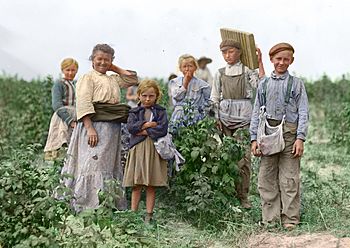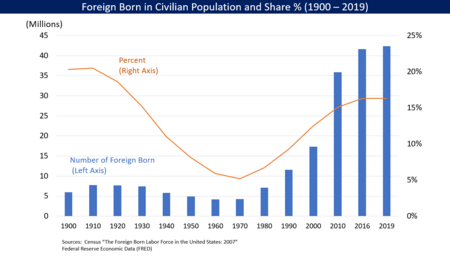Immigration to the United States facts for kids
Immigration to the United States is when people from other countries come to live here permanently. It has greatly helped the U.S. population grow and has brought many different cultures together.
Except for Native Americans, almost everyone in the U.S. can trace their family roots back to immigrants from other parts of the world. The United States has more immigrants than any other country, with about 47 million immigrants in 2015.
In 2016, about 1.18 million people became legal immigrants in the U.S. Studies show that immigration is good for the U.S. economy. Immigrants also tend to have lower crime rates than people born in the U.S.
Contents
A Look at U.S. Immigration History
American immigration history can be divided into four main time periods. Each period brought different groups of people to the United States.
Early Days: Colonial Period Immigration
During the 1600s, about 400,000 English people moved to Colonial America. About half of them stayed for good. They made up most of the white immigrants.
From 1700 to 1775, between 350,000 and 500,000 Europeans arrived. These included Scots, Scots-Irish, Germans, Swiss, and French Huguenots. Also, about 300,000 Africans were brought against their will.
More than half of all European immigrants in the 1600s and 1700s came as indentured servants. This meant they agreed to work for a period of time to pay for their trip.
By 1790, the U.S. population was about 3.9 million people. Historians believe fewer than 1 million immigrants came from Europe between 1600 and 1799.
New Laws and Changing Arrivals (1790s-1900s)
The first U.S. immigration law, the Naturalization Act of 1790, said that only "free white persons" could become citizens. This rule was later changed to include Black people in the 1860s and Asian people in the 1950s.
In the early years of the U.S., fewer than 8,000 immigrants arrived each year. After 1820, this number slowly grew. From 1836 to 1914, over 30 million Europeans came to the U.S. Travel across the ocean was very dangerous, and many people died on the journey.
In 1875, the U.S. passed its first major immigration law, the Page Act of 1875. After many Chinese immigrants came during the California Gold Rush, Congress passed the Chinese Exclusion Act in 1882. This law stopped almost all immigration from China until it was ended in 1943. Later, more immigrants from other Asian countries also started coming, especially to the West Coast.

Immigration in the 20th Century
The most immigrants from Europe arrived in 1907, with over 1.2 million people entering the country. By 1910, 13.5 million immigrants lived in the U.S.
The Immigration Act of 1917 stopped immigration from many Asian countries. It also banned people with certain political beliefs or mental health conditions.
Later, the Emergency Quota Act of 1921 and the Immigration Act of 1924 were passed. These laws aimed to limit immigrants from Southern and Eastern Europe, such as Jews, Italians, and Slavs. They also made the ban on Asian immigration even stronger.
The Great Depression in the 1930s greatly slowed down immigration. In 1929, nearly 280,000 immigrants arrived, but by 1933, only about 23,000 came. For a short time, more people left the U.S. than entered it.
During this time, the U.S. government started a program that encouraged people of Mexican descent to move to Mexico. Many thousands were sent away, even some who were U.S. citizens.
After World War II, in 1954, another program called "Operation Wetback" led to the deportation of over 1 million people of Mexican descent.
Immigration Since 1965
The Immigration and Nationality Act of 1965, also known as the Hart-Cellar Act, changed U.S. immigration rules a lot. It ended the old system that favored immigrants from certain countries. This led to many more immigrants coming from non-European nations, which changed the mix of people in the United States.
In 1970, 60% of immigrants were from Europe. By 2000, this dropped to 15%. In 1990, President George H. W. Bush signed a law that increased legal immigration by 40%. Another law in 1991 made it easier for foreign service members in the U.S. military to become permanent residents or citizens.
In 1994, California voters passed a law called Proposition 187. It tried to stop undocumented immigrants from getting state financial aid. However, federal courts said this law was against the U.S. Constitution.
President Bill Clinton said in 1998 that the U.S. has always been made stronger by immigrants. He called them "the most restless, the most adventurous, the most innovative, the most industrious of people."

From 2000 to 2010, almost 14 million immigrants came to the U.S. In 2008 alone, over one million people became U.S. citizens. Many people who enter the U.S. without permission face a difficult and dangerous journey. This is often because there are very few legal ways for low-skilled workers to get visas or green cards.
Discussions about immigration in the 2000s included ideas like making border security stronger or creating new programs for temporary workers.
Recent Changes: Trump Administration Policies
The Trump Administration made changes to immigration rules, making it harder for people seeking asylum. In April 2020, President Trump announced a temporary stop to immigration to the U.S. because of the COVID-19 pandemic.
Images for kids
-
Operation Allies Refuge: Afghans being evacuated on a US Air Force Boeing C-17 plane during the Fall of Kabul (2021)
-
Naturalization ceremony, Salem, Massachusetts, 2007
-
Crowd at the Philippine Independence Day Parade in New York City
-
A U.S. green card, a document confirming permanent resident status for eligible immigrants.
-
The Statue of Liberty was a common sight to many immigrants who entered the United States through Ellis Island.
See also
 In Spanish: Inmigración en los Estados Unidos para niños
In Spanish: Inmigración en los Estados Unidos para niños















